
Understanding Grotesquerie Casts: Interplay of Beauty and the Repulsive
Introduction
Grotesquerie casts, an intriguing and enigmatic art form, have fascinated and disturbed audiences for centuries. These castings depict exaggerated, distorted, and often unsettling figures, challenging the traditional boundaries of beauty and repulsion. In this in-depth exploration, we delve into the captivating history, symbolism, and significance of grotesque casts.
Origin and Historical Context
Medieval Origins
Grotesquerie casts originated in the Middle Ages, particularly during the Romanesque and Gothic periods. At this time, they found their place as decorative elements in churches and cathedrals. These early casts frequently represented mythical creatures, gargoyles, and grotesque figures drawn from Celtic and Norse mythology, serving as symbolic guardians against evil.
Renaissance Resurgence
During the Renaissance, grotesquerie casts experienced a revival, largely influenced by the excavation of ancient Roman ruins. Artists such as Leonardo da Vinci and Raphael incorporated grotesque elements into their works, recognizing their expressive potential. These casts became less overtly religious, expanding into the realm of secular art.
Symbolism and Interpretation
Ambiguity and Subjectivity
Grotesque casts embrace ambiguity and subjectivity. Their distorted forms and unusual features invite multiple interpretations. Some perceive them as representations of the grotesque, the monstrous, and the grotesque, while others see them as symbols of the carnivalesque, the liberating, and the transgressive.
Hybridity and Transformation
These casts often merge human and animal traits, blurring the boundaries between the familiar and the foreign. This hybridity suggests fluidity, transformation, and the impermanence of physical forms. They challenge conventional notions of beauty and normality, inviting viewers to confront their own prejudices and societal expectations.
Grotesquerie in Literature and Art
Literary Grotesques
Grotesquerie has also found expression in literature. Writers like Edgar Allan Poe and Franz Kafka employed grotesque characters and imagery to explore themes of alienation, anxiety, and the irrational. These literary grotesques embody the uncanny, the unsettling, and the paradoxical.
Artistic Manifestations
In the visual arts, grotesque casts continue to captivate contemporary artists. Surrealists like Salvador Dalí and Hans Bellmer embraced the grotesque as a means of disrupting established norms and unconscious desires. Contemporary artists continue to explore the grotesque, using it to comment on social issues, political turmoil, and the human psyche.
Conclusion
Grotesque casts stand as compelling and thought-provoking works of art. They challenge traditional conceptions of beauty and repulsiveness, and their symbolism and interpretation remain open to debate. Through their distorted forms and ambiguous meanings, grotesque casts encourage us to question our own assumptions, embrace the unconventional, and recognize the transformative power of the grotesque.